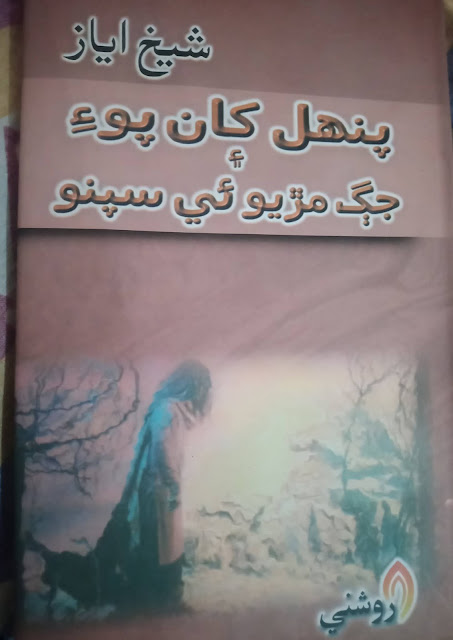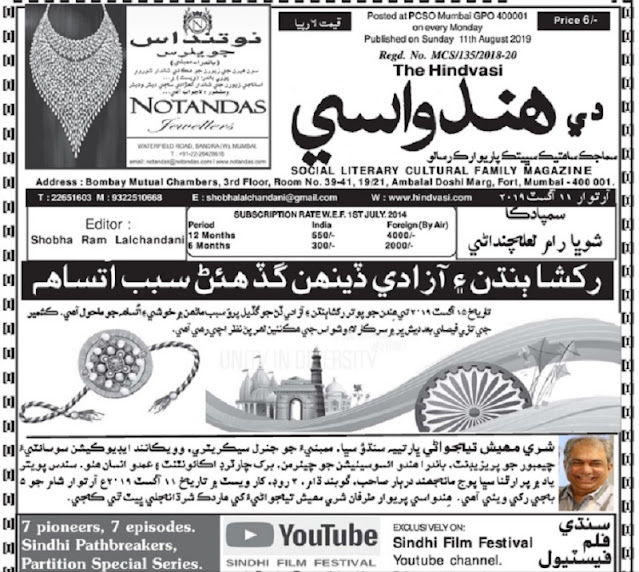Shaikh Ayaz And His Short Stories
The great Sindhi poet Shaikh Ayaz is widely known and revered
mainly for his poetry; and is often mentioned as the Imam of modern
Sindhi poetry, he introduced variety of latest trends through his poetry.
Renowned writer and intellectual Mohd. Ibrahim Joyo, while commenting on Shaikh
Ayaz’s poetry mentioned: “Shaikh Ayaz’s poetry is a miracle of Sindhi language”,
It is mostly commonly narrated that it was this great man Mohd.
Ibrahim Joyo, who asked Shaikh Ayaz to write poetry in Sindhi language, as
Shaikh Ayaz started his writing career in Urdu language, while having dialogue
with Mr. Joyo, when Ayaz was asked to write in Sindhi, he replied:
“Who would read me in Sindhi?”
“The people of Sindh would make you a literary icon,” replied Mr.
Joyo. And truly said Ayaz became an icon of modern day poetry in Sindhi
language. He became such a powerful voice of Sindh that many of his books were
banned in different regimes, while he was jailed for what he wrote.
This legendary poet was born on 02nd March 1923 at
Shikarpur, he was educated and became a lawyer, later on he moved to Karachi,
the capital of Sindh, when he was only 13 years old he started to write poetry
and it was published in the famous literary magazine of that time “Sindhu”.
At the age of 17 he started writing short stories and a collection of his
stories titled “Sufaid Vehshi” (White Monster) was published before the
partition of India took place, he was praised for some of his stories including
“Khilani” (The Smiling One), “Char Acre Bani” (Four Acres of
Land), “Nooran”, “Watch Ja Kanta” (Pins of Watch), and “Karo
Rang” (Black Color). Two collections of his short stories named “Punhal
Khaun Po” and “Jag Mirioyee Sapno”, were published and later on in
2008, both these books were compiled into one book and was published by Roshni
Publication.
It is also associated that Shaikh Ayaz was writing a novel that he
was unable to complete and was bedridden due to ill health, he passed away on
28th December 1997 at the age of 74, and is buried at Bhit Shah.
While going through Shaikh
Ayaz’s short stories, it seems that he was thoroughly inspired by realism, all
of his stories have real settings, class conflict, romance, characters who are
suppressed and oppressed, yet they keep on fighting and struggling, while he
narrates stories in simple language. Some of his stories are written on the
partition including “Parisari” (Neighbor) and “Jay Tand Barbar
Toriyan” and they were including in an anthology of Sindhi short stories on
partition of India, compiled by Late Shoukat Hussain Shoro and Murlidhar Jatley
that was published by Sindhi Academy, Delhi in 2018.
If we analyze his short story “Parisari” on one hand it
portrays the enthusiasm among Sindhi Muslims for creating a new homeland after
being separated from India, while on the other hand it portrays the unrest, uncertainty
and vulnerability of Sindhi Hindus. The protagonist of this story is a Muslim
hairdresser named “Khano” who is supporter of Muslim League and a
believer, as the news of riots from different parts reach Khano’s ears,
he becomes starts thinking how can he slit throats of his neighbors, with whom
he has spent his entire life, and like a common Sindhi Khano starts
thinking that religious riots won’t take place in Sindh as it is the land of
Sufis.
Commenting on the second story on partition Late Mr. Shoukat Shoro
wrote that: “it is written in poetic diction, as the protagonist of the story
is a poet and he farewells his friend Shayam, who is leaving for India from
Karachi, the capital of Sindh after partition, they both are poets and have
sung songs of greatness of their motherland. It seems that the character of
Shayam resembles that of Sindhi poet Naryain Shayam, who was a close friend of
Shaikh Ayaz and left Sindh after partition, while saying farewell to his friend
Shayam says:
“We thought we were creating history, never considering we were
actually distorting it.”
Another story Khilani is among one of his best stories, it
is about a young girl full of life and who always keeps on laughing even on
small things, she is able to sting people with her beauty, yet she is a shy
girl.
The story starts with a beautiful sentence that has become
matchless opening line in Sindhi prose fiction:
“There was trickiness in her simplicity, and simplicity in her
tricks…”
While another story “Karo Rang” is written on complex of
having black skin, and even this story opens with beautiful lines:
“She was black in color, as though back of a cooking pan, her face
used to light up when she came out after taking bath and putting cream on her
face that melted due to heat, her beautiful black color seemed to freshen up.
You must be wondering how I could call her beautiful!”
There are many stories and
characters in these two collections that reflect Sindhi society, its people and
its trends and traditions. Though Ayaz is popular for his poetry that is widely
read throughout Sindh, but his short stories are also a treat to read.





Comments
Post a Comment